engine coolant HONDA CR-V 2017 RM1, RM3, RM4 / 4.G User Guide
[x] Cancel search | Manufacturer: HONDA, Model Year: 2017, Model line: CR-V, Model: HONDA CR-V 2017 RM1, RM3, RM4 / 4.GPages: 657
Page 552 of 657
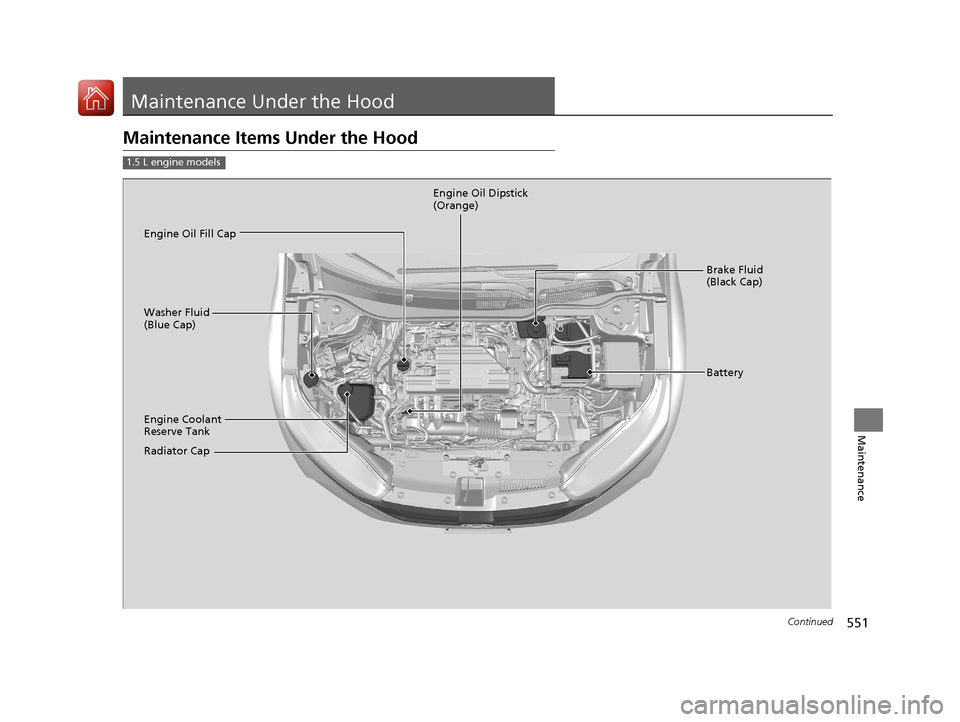
551Continued
Maintenance
Maintenance Under the Hood
Maintenance Items Under the Hood
1.5 L engine models
Brake Fluid
(Black Cap)
Engine Coolant
Reserve Tank
Radiator Cap Washer Fluid
(Blue Cap) Engine Oil Dipstick
(Orange)
Engine Oil Fill Cap
Battery
17 CR-V-31TLA6000.book 551 ページ 2016年10月11日 火曜日 午後6時37分
Page 553 of 657
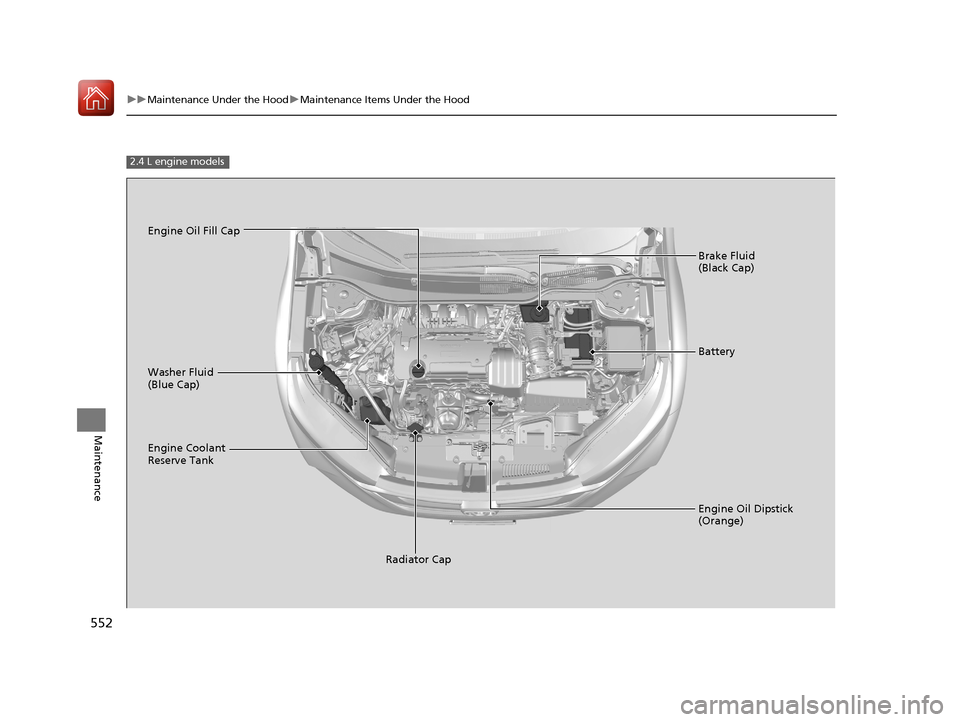
552
uuMaintenance Under the Hood uMaintenance Items Under the Hood
Maintenance
2.4 L engine models
Brake Fluid
(Black Cap)
Engine Coolant
Reserve Tank Radiator Cap
Washer Fluid
(Blue Cap)
Engine Oil Dipstick
(Orange)
Engine Oil Fill Cap
Battery
17 CR-V-31TLA6000.book 552 ページ 2016年10月11日 火曜日 午後6時37分
Page 562 of 657
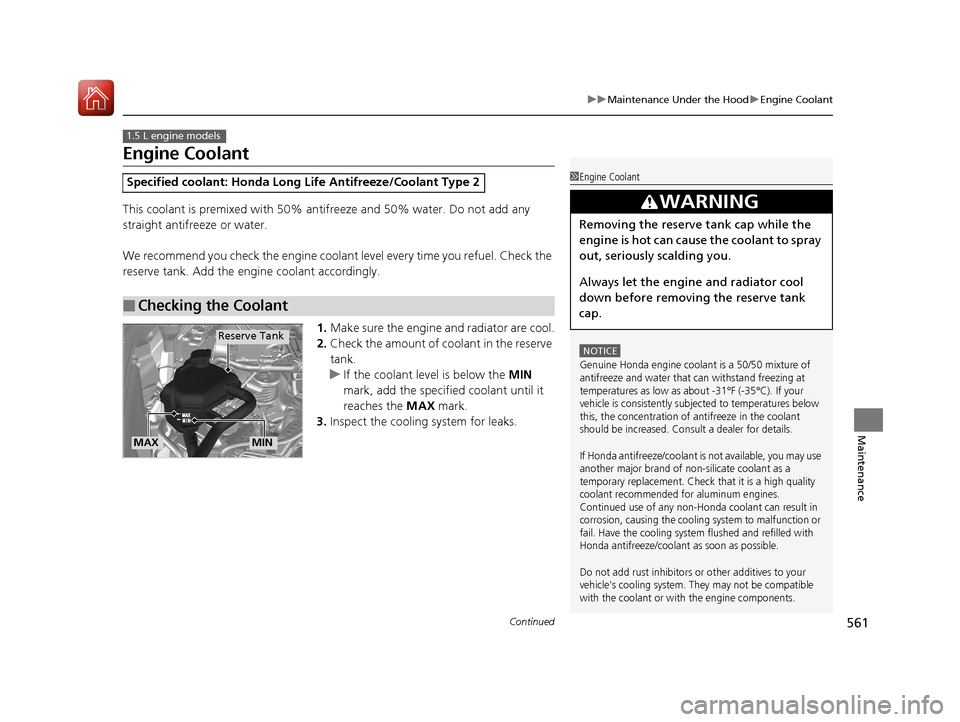
561
uuMaintenance Under the Hood uEngine Coolant
Continued
Maintenance
Engine Coolant
This coolant is premixed with 50% an tifreeze and 50% water. Do not add any
straight antifreeze or water.
We recommend you check the engine coolant level every time you refuel. Check the
reserve tank. Add the engine coolant accordingly.
1.Make sure the engine and radiator are cool.
2. Check the amount of coolant in the reserve
tank.
u If the coolant level is below the MIN
mark, add the specified coolant until it
reaches the MAX mark.
3. Inspect the cooling system for leaks.
Specified coolant: Ho nda Long Life Antifreeze/Coolant Type 2
■Checking the Coolant
1.5 L engine models
1Engine Coolant
NOTICE
Genuine Honda engine coolant is a 50/50 mixture of
antifreeze and water that can withstand freezing at
temperatures as low as about -31°F (-35°C). If your
vehicle is consistently subjected to temperatures below
this, the concentration of antifreeze in the coolant
should be increased. Consult a dealer for details.
If Honda antifreeze/coolant is not available, you may use
another major brand of non-silicate coolant as a
temporary replacement. Check that it is a high quality
coolant recommended for aluminum engines.
Continued use of any non-Honda coolant can result in
corrosion, causing the cooling system to malfunction or
fail. Have the cooling system flushed and refilled with
Honda antifreeze/coolant as soon as possible.
Do not add rust inhibitors or other additives to your
vehicle's cooling system. They may not be compatible
with the coolant or with the engine components.
3WARNING
Removing the reserve tank cap while the
engine is hot can cause the coolant to spray
out, seriously scalding you.
Always let the engine and radiator cool
down before removing the reserve tank
cap.
Reserve Tank
MAXMIN
17 CR-V-31TLA6000.book 561 ページ 2016年10月11日 火曜日 午後6時37分
Page 563 of 657
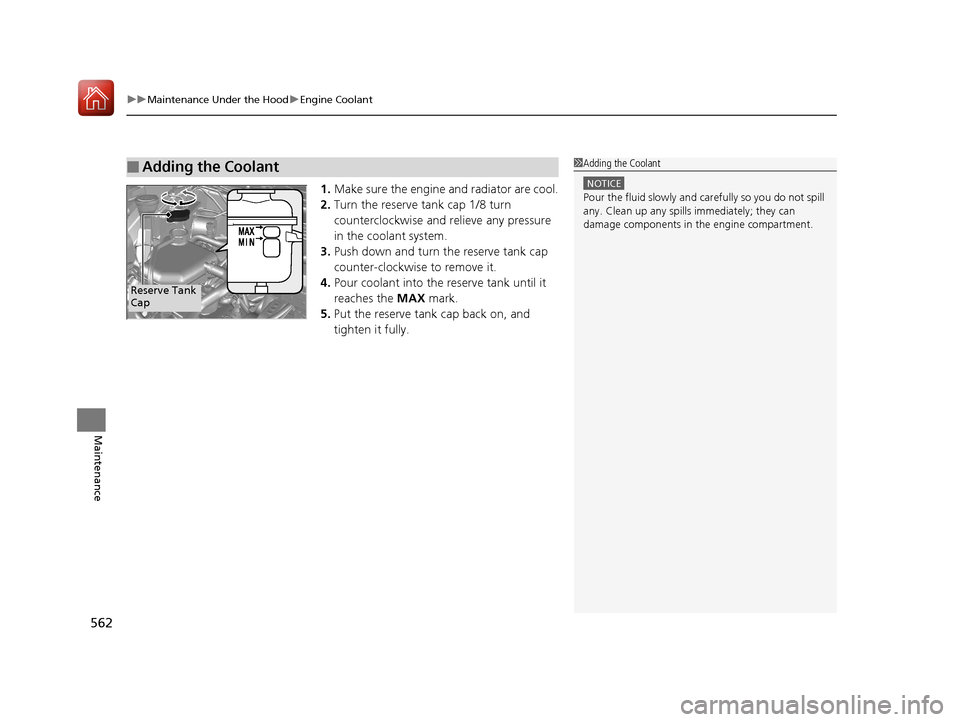
uuMaintenance Under the Hood uEngine Coolant
562
Maintenance
1. Make sure the engine and radiator are cool.
2. Turn the reserve tank cap 1/8 turn
counterclockwise and relieve any pressure
in the coolant system.
3. Push down and turn the reserve tank cap
counter-clockwise to remove it.
4. Pour coolant into the reserve tank until it
reaches the MAX mark.
5. Put the reserve tank cap back on, and
tighten it fully.
■Adding the Coolant1Adding the Coolant
NOTICE
Pour the fluid slowly and ca refully so you do not spill
any. Clean up any spills immediately; they can
damage components in the engine compartment.
Reserve Tank
Cap
17 CR-V-31TLA6000.book 562 ページ 2016年10月11日 火曜日 午後6時37分
Page 564 of 657
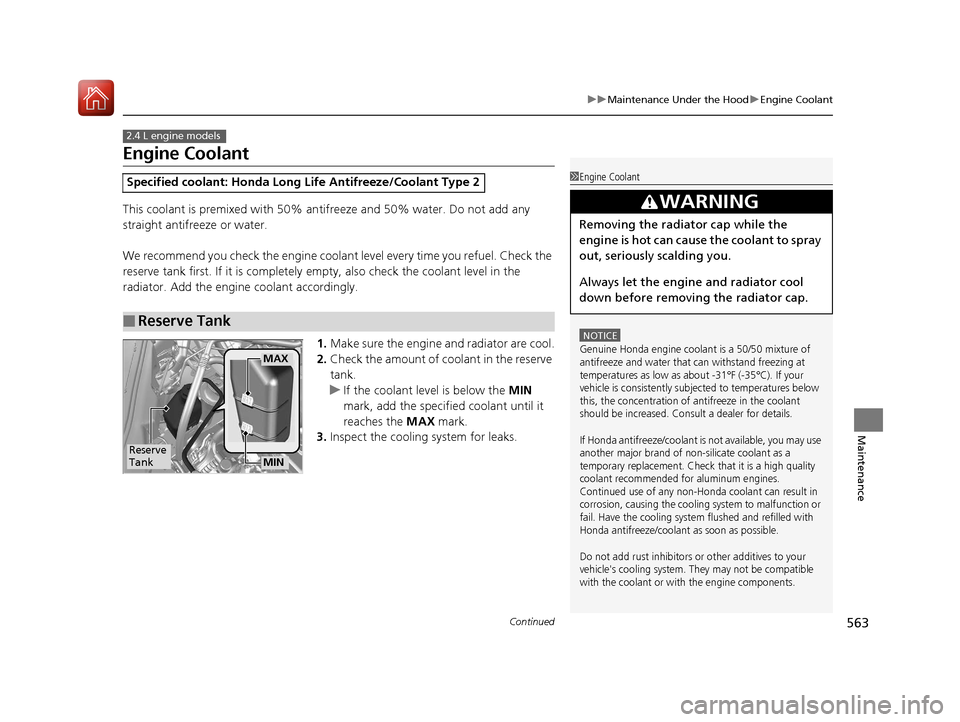
563
uuMaintenance Under the Hood uEngine Coolant
Continued
Maintenance
Engine Coolant
This coolant is premixed with 50% an tifreeze and 50% water. Do not add any
straight antifreeze or water.
We recommend you check the engine coolant level every time you refuel. Check the
reserve tank first. If it is completely empty, also check the coolant level in the
radiator. Add the engine coolant accordingly.
1.Make sure the engine and radiator are cool.
2. Check the amount of coolant in the reserve
tank.
u If the coolant level is below the MIN
mark, add the specified coolant until it
reaches the MAX mark.
3. Inspect the cooling system for leaks.
Specified coolant: Ho nda Long Life Antifreeze/Coolant Type 2
■Reserve Tank
2.4 L engine models
1Engine Coolant
NOTICE
Genuine Honda engine coolant is a 50/50 mixture of
antifreeze and water that can withstand freezing at
temperatures as low as about -31°F (-35°C). If your
vehicle is consistently subjected to temperatures below
this, the concentration of antifreeze in the coolant
should be increased. Consult a dealer for details.
If Honda antifreeze/coolant is not available, you may use
another major brand of non-silicate coolant as a
temporary replacement. Check that it is a high quality
coolant recommended for aluminum engines.
Continued use of any non-Honda coolant can result in
corrosion, causing the cooling system to malfunction or
fail. Have the cooling system flushed and refilled with
Honda antifreeze/coolant as soon as possible.
Do not add rust inhibitors or other additives to your
vehicle's cooling system. They may not be compatible
with the coolant or with the engine components.
3WARNING
Removing the radiator cap while the
engine is hot can cause the coolant to spray
out, seriously scalding you.
Always let the engine and radiator cool
down before removing the radiator cap.
Reserve
Tank
MAX
MIN
17 CR-V-31TLA6000.book 563 ページ 2016年10月11日 火曜日 午後6時37分
Page 565 of 657
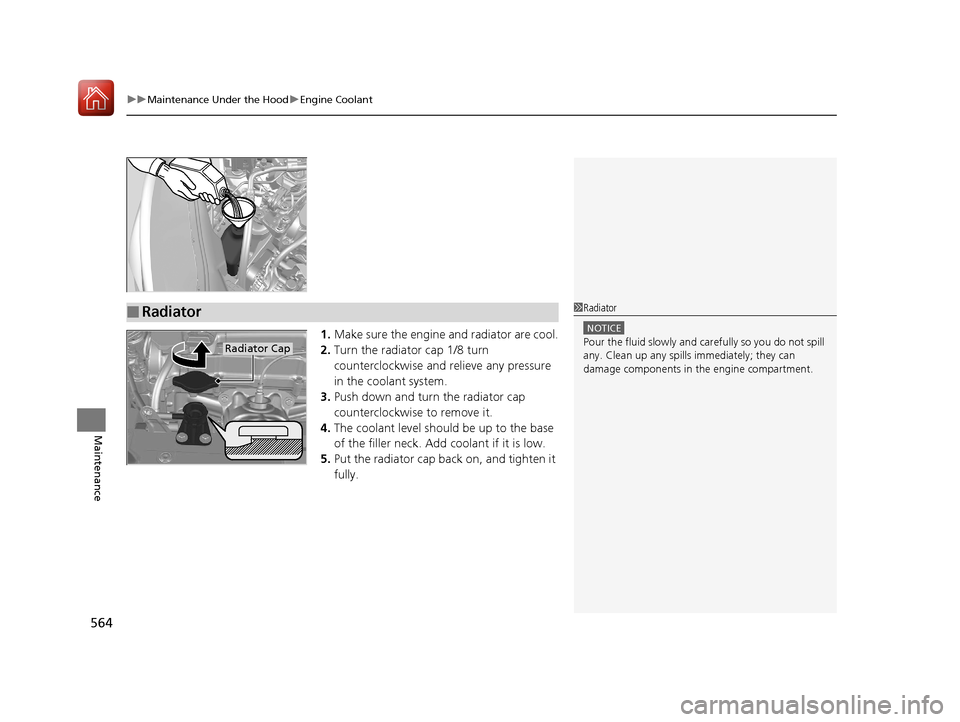
uuMaintenance Under the Hood uEngine Coolant
564
Maintenance
1. Make sure the engine and radiator are cool.
2. Turn the radiator cap 1/8 turn
counterclockwise and relieve any pressure
in the coolant system.
3. Push down and turn the radiator cap
counterclockwise to remove it.
4. The coolant level should be up to the base
of the filler neck. Add coolant if it is low.
5. Put the radiator cap back on, and tighten it
fully.
■Radiator1Radiator
NOTICE
Pour the fluid slowly and ca refully so you do not spill
any. Clean up any spills immediately; they can
damage components in the engine compartment.Radiator Cap
17 CR-V-31TLA6000.book 564 ページ 2016年10月11日 火曜日 午後6時37分
Page 597 of 657

uuCleaning uExterior Care
596
Maintenance
A good coat of automotive body wax helps protect your vehicle’s paint from the
elements. Wax will wear off over time and expose your vehicle’s paint to the
elements, so reapply as necessary.
If you get gasoline, oil, engine coolant, or battery fluid on resin coated parts, they
may be stained or the coating may peel. Prom ptly wipe it away using a soft cloth and
clean water.
Wipe using a glass cleaner.
Aluminum is susceptible to deterioration caused by salt and other road
contaminants. When necessary, as early as possible use a sponge and mild detergent
to wipe away these contaminants. Do no t use a stiff brush or harsh chemicals
(including some commercial wheel cleaners). These can damage the protective finish
on aluminum alloy wheels, resulting in corrosion. Depending on the type of finish,
the wheels also may lose their luster or appear burnished. To avoid water stains,
wipe the wheels dry with a cloth while they are still wet.
■Applying Wax
■Maintaining the Bumpers and Other Resin Coated Parts
■Cleaning the Window
■Maintaining Aluminum Wheels
1 Applying Wax
NOTICE
Chemical solvents and st rong cleaners can damage
the paint, metal, and plasti c on your vehicle. Wipe
away spills immediately.
1 Maintaining the Bumpers an d Other Resin Coated Parts
Ask a dealer about the correct coating material when
you want to repair the pa inted surface of the parts
made of resin.
17 CR-V-31TLA6000.book 596 ページ 2016年10月11日 火曜日 午後6時37分
Page 617 of 657
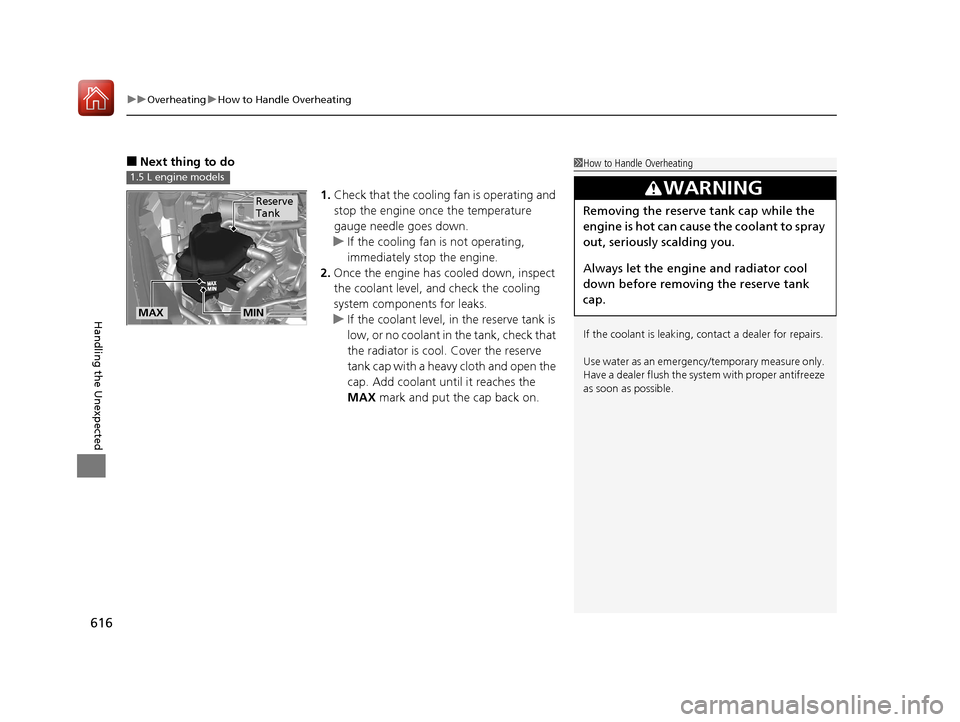
uuOverheating uHow to Handle Overheating
616
Handling the Unexpected
■Next thing to do
1.Check that the cooling fan is operating and
stop the engine once the temperature
gauge needle goes down.
u If the cooling fan is not operating,
immediately stop the engine.
2. Once the engine has cooled down, inspect
the coolant level, an d check the cooling
system components for leaks.
u If the coolant level, in the reserve tank is
low, or no coolant in the tank, check that
the radiator is cool. Cover the reserve
tank cap with a heavy cloth and open the
cap. Add coolant until it reaches the
MAX mark and put the cap back on.1How to Handle Overheating
If the coolant is leaking, contact a dealer for repairs.
Use water as an emergency/temporary measure only.
Have a dealer flush the system with proper antifreeze
as soon as possible.
3WARNING
Removing the reserve tank cap while the
engine is hot can cause the coolant to spray
out, seriously scalding you.
Always let the engine and radiator cool
down before removing the reserve tank
cap.
1.5 L engine models
Reserve
Tank
MAXMIN
17 CR-V-31TLA6000.book 616 ページ 2016年10月11日 火曜日 午後6時37分
Page 618 of 657
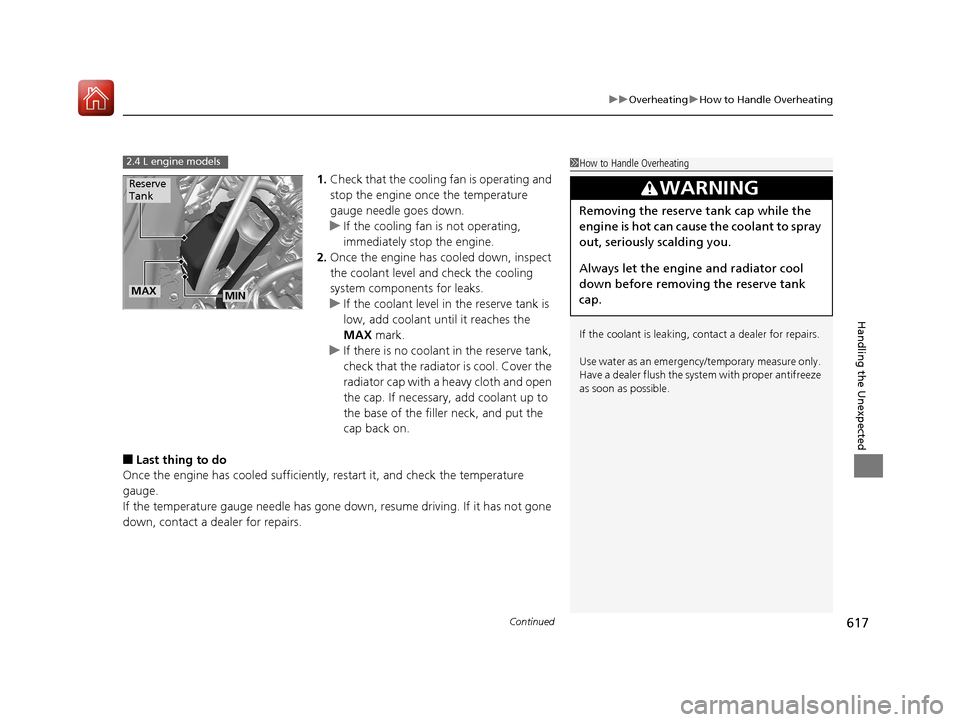
Continued617
uuOverheating uHow to Handle Overheating
Handling the Unexpected
1. Check that the cooling fan is operating and
stop the engine once the temperature
gauge needle goes down.
u If the cooling fan is not operating,
immediately stop the engine.
2. Once the engine has cooled down, inspect
the coolant level and check the cooling
system components for leaks.
u If the coolant level in the reserve tank is
low, add coolant until it reaches the
MAX mark.
u If there is no coolant in the reserve tank,
check that the radiator is cool. Cover the
radiator cap with a heavy cloth and open
the cap. If necessary, add coolant up to
the base of the filler neck, and put the
cap back on.
■Last thing to do
Once the engine has cooled sufficiently, restart it, and check the temperature
gauge.
If the temperature gauge needle has gone dow n, resume driving. If it has not gone
down, contact a dealer for repairs.
1 How to Handle Overheating
If the coolant is leaking, contact a dealer for repairs.
Use water as an emergency/temporary measure only.
Have a dealer flush the system with proper antifreeze
as soon as possible.
3WARNING
Removing the reserve tank cap while the
engine is hot can cause the coolant to spray
out, seriously scalding you.
Always let the engine and radiator cool
down before removing the reserve tank
cap.
2.4 L engine models
Reserve
Tank
MAXMIN
17 CR-V-31TLA6000.book 617 ページ 2016年10月11日 火曜日 午後6時37分
Page 636 of 657
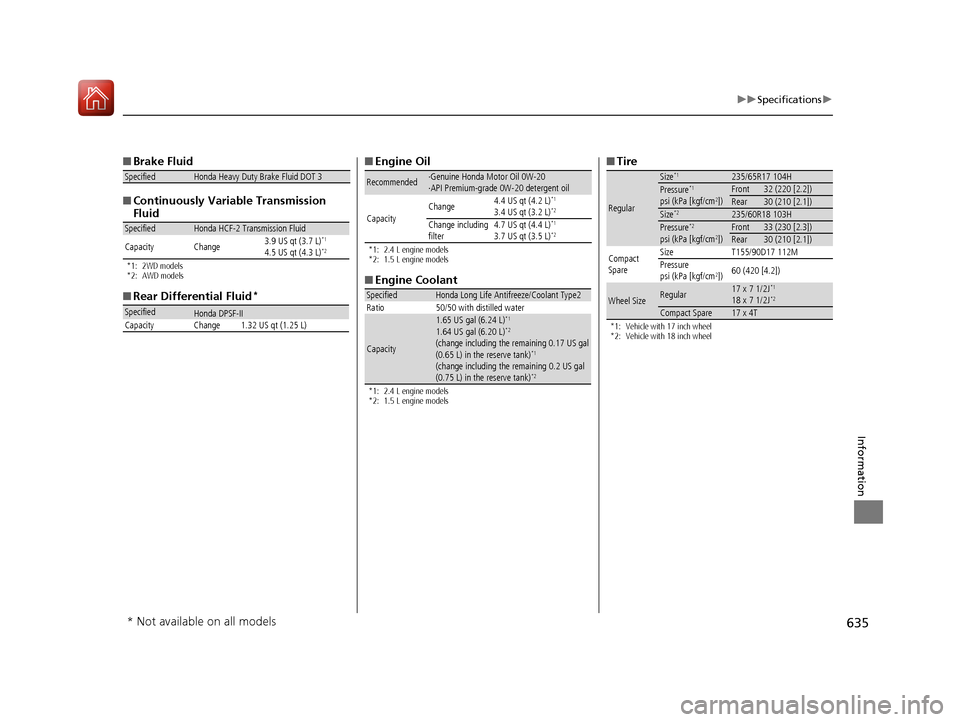
635
uuSpecifications u
Information
■Brake Fluid
■ Continuously Variable Transmission
Fluid
*1: 2WD models
*2: AWD models
■Rear Differential Fluid*
SpecifiedHonda Heavy Duty Brake Fluid DOT 3
SpecifiedHonda HCF-2 Transmission Fluid
Capacity Change 3.9 US qt (3.7 L)*1
4.5 US qt (4.3 L)*2
SpecifiedHonda DPSF-II
Capacity Change 1.32 US qt (1.25 L)
■ Engine Oil
*1: 2.4 L engine models
*2: 1.5 L engine models
■Engine Coolant
*1: 2.4 L engine models
*2: 1.5 L engine models
Recommended·Genuine Honda Motor Oil 0W-20
·API Premium-grade 0W-20 detergent oil
Capacity Change
4.4 US qt (4.2 L)
*1
3.4 US qt (3.2 L)*2
Change including
filter4.7 US qt (4.4 L)*1
3.7 US qt (3.5 L)*2
SpecifiedHonda Long Life Antifreeze/Coolant Type2
Ratio 50/50 with distilled water
Capacity
1.65 US gal (6.24 L)*1
1.64 US gal (6.20 L)*2
(change including the remaining 0.17 US gal
(0.65 L) in the reserve tank)*1
(change including the remaining 0.2 US gal
(0.75 L) in the reserve tank)*2
■ Tire
*1: Vehicle with 17 inch wheel
*2: Vehicle with 18 inch wheel
Regular
Size*1235/65R17 104HPressure*1
psi (kPa [kgf/cm2])Front32 (220 [2.2])Rear30 (210 [2.1])Size*2235/60R18 103HPressure*2
psi (kPa [kgf/cm2])Front33 (230 [2.3])Rear30 (210 [2.1])
Compact
Spare Size
T155/90D17 112M
Pressure
psi (kPa [kgf/cm
2]) 60 (420 [4.2])
Wheel SizeRegular17 x 7 1/2J*1
18 x 7 1/2J*2
Compact Spare17 x 4T
* Not available on all models
17 CR-V-31TLA6000.book 635 ページ 2016年10月11日 火曜日 午後6時37分